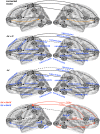Effective cerebral connectivity during silent speech reading revealed by functional magnetic resonance imaging
- PMID: 24278266
- PMCID: PMC3837007
- DOI: 10.1371/journal.pone.0080265
Effective cerebral connectivity during silent speech reading revealed by functional magnetic resonance imaging
Erratum in
- PLoS One. 2014;9(5):e97210
Abstract
Seeing the articulatory gestures of the speaker ("speech reading") enhances speech perception especially in noisy conditions. Recent neuroimaging studies tentatively suggest that speech reading activates speech motor system, which then influences superior-posterior temporal lobe auditory areas via an efference copy. Here, nineteen healthy volunteers were presented with silent videoclips of a person articulating Finnish vowels /a/, /i/ (non-targets), and /o/ (targets) during event-related functional magnetic resonance imaging (fMRI). Speech reading significantly activated visual cortex, posterior fusiform gyrus (pFG), posterior superior temporal gyrus and sulcus (pSTG/S), and the speech motor areas, including premotor cortex, parts of the inferior (IFG) and middle (MFG) frontal gyri extending into frontal polar (FP) structures, somatosensory areas, and supramarginal gyrus (SMG). Structural equation modelling (SEM) of these data suggested that information flows first from extrastriate visual cortex to pFS, and from there, in parallel, to pSTG/S and MFG/FP. From pSTG/S information flow continues to IFG or SMG and eventually somatosensory areas. Feedback connectivity was estimated to run from MFG/FP to IFG, and pSTG/S. The direct functional connection from pFG to MFG/FP and feedback connection from MFG/FP to pSTG/S and IFG support the hypothesis of prefrontal speech motor areas influencing auditory speech processing in pSTG/S via an efference copy.
Conflict of interest statement
Figures



References
-
- Sumby WH, Pollack I (1954) Visual contribution to speech intelligibility in noise. Journal of the Acoustical Society of America 26: 212–215.
-
- Ross LA, Saint-Amour D, Leavitt VM, Javitt DC, Foxe JJ (2007) Do you see what I am saying? Exploring visual enhancement of speech comprehension in noisy environments. Cereb Cortex 17: 1147–1153. - PubMed
-
- McGurk H, MacDonald J (1976) Hearing lips and seeing voices. Nature 264: 746–748. - PubMed
-
- Calvert GA, Campbell R, Brammer MJ (2000) Evidence from functional magnetic resonance imaging of crossmodal binding in the human heteromodal cortex. Curr Biol 10: 649–657. - PubMed
-
- Campbell R, MacSweeney M, Surguladze S, Calvert GA, McGuire P, et al. (2001) Cortical substrates for the perception of face actions: an fMRI study of the specificity of activation for seen speech and for meaningless lower-face acts (gurning). Brain Res Cogn Brain Res 12: 233–243. - PubMed
Publication types
MeSH terms
LinkOut - more resources
Full Text Sources
Other Literature Sources
Medical

